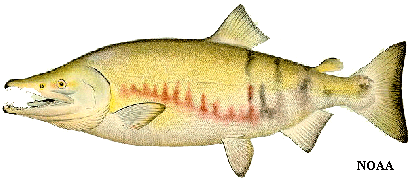|
|
|
||||||
 Salmon, Chum
(Onceorthychus
keta) Keta, Dog Salmon, Silverbrights,
Semibrights, Fall Chums, Dark Chums, Calico Chums, Qualla Chums Salmon, Chum
(Onceorthychus
keta) Keta, Dog Salmon, Silverbrights,
Semibrights, Fall Chums, Dark Chums, Calico Chums, Qualla ChumsThe chum salmon is the second largest of the Pacific salmon; they have been recorded up to 33 pounds but the average size is between 10 and 15 pounds. Because of the large and fearsome-looking canine teeth the chum salmon develops during spawning runs, the name dog salmon is often applied. The Chum has a mild flavor and flesh of pink to red and a coarse firm texture with moderate oil content. Harvested during the salmon season between August and September the chums are always net caught. Chum Salmon have the widest distribution of any of the Pacific salmon. They range south to the Sacramento River in California and the island of Kyushu in the Sea of Japan. In the north they range east in the Arctic Ocean to the Mackenzie River in Canada and west to the Lena River in Siberia. Chum salmon are the most abundant commercially harvested salmon species in arctic, northwestern, and interior Alaska, but are of relatively less importance in other areas of the state. The heaviest production comes from Alaska with smaller runs from British Columbia and Puget Sound. As the fish enter the fresh water the silvery skin becomes darker above the lateral line and the flesh becomes paler. These fish are called semibrights . As more makings appear like the red and lack bars on the sides as they approach spawning they are called brights and darks. Grading is important. Semibrights or brights are
watermarked above the lateral line. When watermarks are below the
lateral line the fish are called fall chum, dark chum, calico chum and
qualla chum. These salmon's flesh make be pink in color but the
flesh will be soft and without flavor.
A small roundworm known
as Anisakis can be present in salmon. If eaten alive this
parasite can cause internal disorders including vomiting, cramping, and
abdominal pain. |
|||||||
|
|
|||||||
